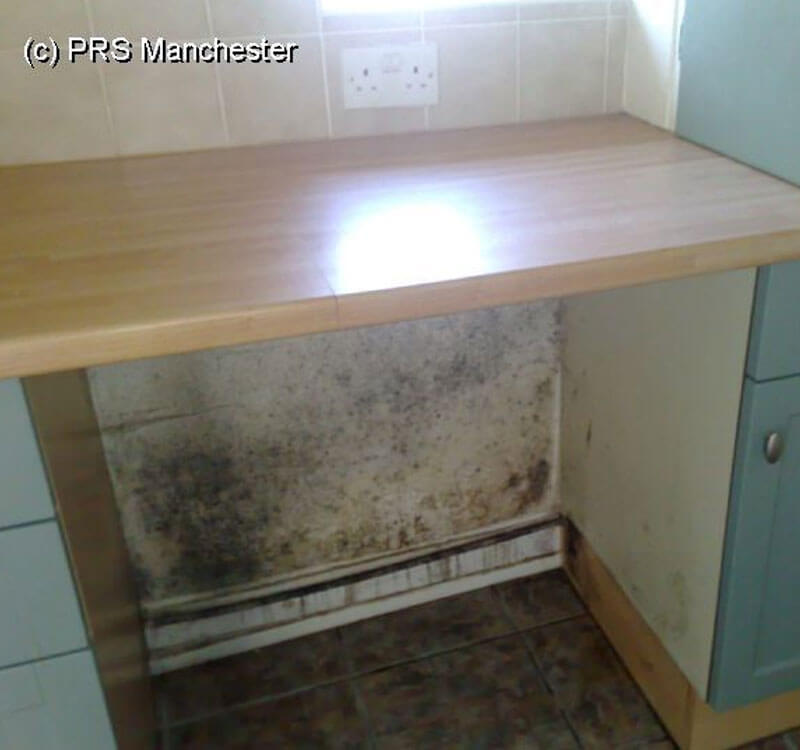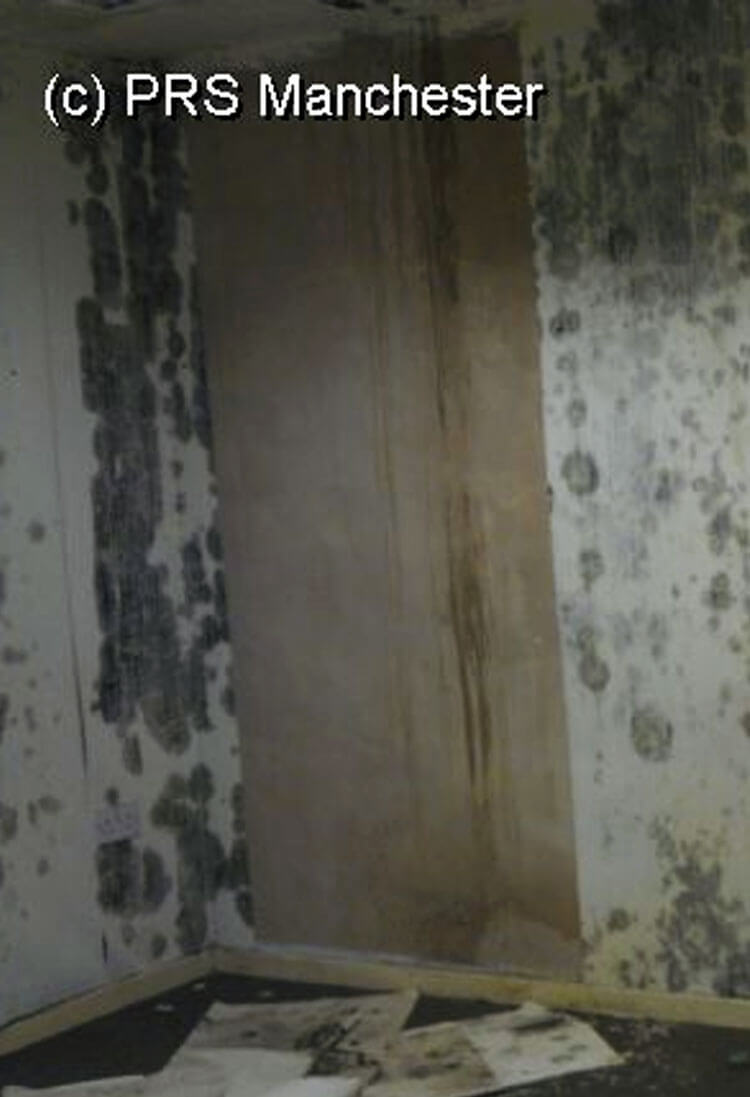Condensation Control and Anti Mould Products
Identification of Condensation
The are three main types of water problems found in properties, Rising Damp, Penetrating Damp and Condensation. In this section we are only dealing with condensation and mould control, the other types of damp and relevant to diagnosis and further details can be found in the damp control section.
Condensation is a prevalent problem in new and old properties, the presence of water streaming down windows, peeling wall paper and black and or green mold growth are all indicators of the condensation problem. These indicators of condensation may be due to low or high amounts of insulation, poorly heated and/or ventilated properties.
To effect a resolution of the condensation and the associated mould problem all these factors need to be taken into consideration. Increasing ventilation or turning up the heating is usually not sufficient to rectify the problem and may result in compounding the condensation problem.
An in depth survey of the property is required, the survey and recommendations to cure the condensation and mold problem may be phased to ensure money and resources are used effectively to achieve the balance required to resolve the problem.It is easy to over spend as different occupiers have different lifestyles which need to be considered.
How to resolve the Condensation and Mould problem
To control the amount of moisture vapour within the property requires different approaches to the different life styles of the occupiers.
A balance of ventilation, heat recovery and control together with increased insulation need to be considered. These considerations for comfortable living conditions with economical use of the existing installations and what may need to be introduced as a resolution can be discussed with our surveying team.
The level of condensation moisture in the property will need to be reduced and heating made effective, when the balance is achieved any mold growth and damaged decoration can be rectified.
Mould growth will stop occurring when the condensation in the property has been removed and controlled allowing the property to dry out, removal with anti mould solutions in spray or hand application and incorporating anti mould additives in the new decoration will then prevent further mould growth. PRS offer a mold cleaning service or products are available through our on line shop.

Above is a view of black mould (Aspergillus) behind kitchen units

What needs to be considered and why?
Whole House Heat Recovery & Ventilation :-
Suitable ventilation is necessary, our houses have been sealed to help reduce heat loss and often installed extraction fans are not used. Additional ventilation needs to be effective without just extracting all the warm air within the property. Humidity controlled extractor fans and heat recovery ventilation (HRV) systems are an effective aid to ventilation as they are automatically controlled and do not rely on the occupier to assist control. Ventilation that imputes air from the loft or from external walls called positive input ventilation (PIV) units make use of the warmer air in the loft are also effective for whole house ventilation. These products are available on a supply and install basis from PRS or these products can be purchased for your own installation via our on line shop. www.dampshop.com
Heating:-
The level of heating in a property is relevant as fuel is expensive and many people use heating intermittently to suit their life style. If the heating is off for long periods of time moisture in the form of water vapor will not be contained in the air but will condense on the cold areas within the property as condensation and this clean water is suitable for the growth of molds. The use of time controls and thermostatic radiator valves can increase the level of heating control within the affected property, often at no extra cost.
Insulation:-
Sufficient insulation is essential in keeping heating bills to an affordable level and ensuring the occupiers have a level of comfort within the property. There are many subsidised options such as cavity wall insulation and loft insulation, these are essential consideration to ensure an economical resolution to condensation problems. More expensive and methods used during renovation or building refurbishment are insulated plaster boards used internally and insulation with renders used externally. This type of work is carried out by PRS. Insulation
Condensation Technical Information
Recognition and Causes of Condensation
Condensation in buildings has risen from a level of comparative insignificance to become a major domestic problem. This can be attributed to changes in design of living accommodation and in the lifestyle of the occupants. A major factor in the last few years has been escalating fuel costs changes to building design and a growing public awareness of the need to conserve energy resulting in more widespread use of double glazing, better draught exclusion.
What is Condensation? Condensation as the name suggests is water which has condensed from warm, moist air on contact with a cold surface. Air holds water in the form of water vapor (moisture). Warm air is able to hold more moisture than cold air. Air which contains its maximum moisture content is said to be saturated. Roughly speaking the amount doubles for every 10 C rise in temperature.
The amount of moisture in the air is usually expressed as Relative Humidity (RH). Saturated air is said to have 100% RH. The RH of air with particular moisture content will vary with temperature; so as the air is cooled its relative humidity will increase.
Below 90C the air in the above example would be incapable of holding any more moisture and the surplus would be released as condensation. The temperature at which this occurs is known as the Dew Point and is dependent upon the amount of moisture in the air. The higher the moisture content the higher the Dew Point.
| Air Temperature | Max Moisture Content |
| 0°C | 0.38% |
| 10°C | 0.77% |
| 20°C | 1.47% |
| 30°C | 2.68% |
0.74% Moisturecontent
| Air Temperature | Max Moisture Content |
| 20°C | 50% |
| 15°C | 68% |
| 10°C | 95% |
| 9°C | 100% |
When does Condensation occur?
Condensation is chiefly a winter problem. The external air temperature is low and external walls and windows are cold.-
The usual sequence of events is as follows:
The amount of moisture in the air is usually expressed as Relative Humidity (RH). Saturated air is said to have 100% RH. The RH of air with particular moisture content will vary with temperature; so as the air is cooled its relative humidity will increase.
Below 90C the air in the above example would be incapable of holding any more moisture and the surplus would be released as condensation. The temperature at which this occurs is known as the Dew Point and is dependent upon the amount of moisture in the air. The higher the moisture content the higher the Dew Point.
- Cold air enters the building
- The air is warmed for the comfort of the occupants.
- The warm air takes up moisture.
- The warm, moist air comes into contact with cold surfaces, walls, windows, etc. and is cooled below its Dew Point.
- Condensation occurs as the excess moisture is released.
Walls in kitchens and bathrooms (where atmospheric moisture levels are usually highest), solid external walls, un-insulated solid floors and cold bridges such as concrete lintels set in cavity walls are commonly the areas in which condensation takes place.
Intermittent heating and cooling of the property can aggravate condensation problems, since it allows warn damp air to cool, reducing its capacity to hold water.
Dew points are reduced allowing condensation to occur. When the air is reheated water is taken back into the air only to be deposited again when the air temperature drops again.
Sources of Moisture
The main sources of moisture in domestic properties are:
The human and animal occupants, cooking, clothes washing and drying, bathing, dish washing, un-ventilated gas heaters etc. Excluding heating it is estimated that a family of 4 with associated cooking, laundering, etc will generate almost 14 litres of water a day. In addition, a free standing gas heater could contribute a further 5 litres of water vapour. This water, in the form of water vapour, must be absorbed by the air in the house or deposited out as condensation if corrective action is not taken. It is worth noting that damp walls and solid floors do not contribute in any significant way to the atmospheric water that leads to the surface, condensation.
Problems caused by condensation
Running water on windows and walls is perhaps the most immediate indication of a condensation problem. If ignored this can lead to deterioration in the decorative condition of the property, stained curtains and decay in window frames. The appearance of molds on the surface of wallpapers and paints in poorly ventilated areas; e.g. behind large pieces of furniture, in cupboards and in the corners of rooms is not uncommon and in severe cases may occur on furnishing, books, papers and even clothing in wardrobes.
Condensation can occur under suspended floors greatly increasing the chances of a fungal decay in floor timbers.
A much less common form of condensation occurs when the Dew Point is reached, not on the surface of a wall but within the structure of the building itself. This is known as interstitial condensation and can easily be mistaken for rising damp or penetrating damp.
Overcoming Condensation
It has been shown that condensation results from moist air coming into contact with cold surfaces and that the likelihood of condensation increases with the amount of moisture in the air. Mold development within a building is unlikely to occur if the Relative Humidity is maintained below 70%. Heating the air alone is unlikely to be a satisfactory solution, not only on grounds of cost, but also of practicality. Unless cold surfaces are eliminated, condensation at some point is inevitable. Any remedial action, therefore, must involve both a lowering of moisture levels and the elimination of cold surfaces.
Improved heating and ventilation coupled with specific action in relation to cold spots will usually result in a significant improvement in conditions, although there may be circumstances in which alternative methods are required. A modest but constant background heat if preferable to intermittent heating since this will help to maintain a higher ambient temperature in the fabric of the building.
The installation of a small extractor fan in a kitchen or bathroom will carry away moisture-laden air from the two areas most responsible for condensation with minimal running costs. This is now required by the Building Regulations in new construction. Extractor fans are now available which incorporate a humidistat which will control the operation of the fan within certain humidity limits. It is also possible to install fans that have an integrated heat exchanger. These have the advantage of providing effective ventilation while reducing heat loss from the property.
Where an open fire or fixed gas fire exists, a certain amount of ventilation will occur and where additional ventilation is provided it is important that this is not blocked off.
Particularly cold walls can be insulated by utilising thermally efficient wall linings or wall plasters, however, the provision of a vapour barrier on the warm side of the insulation may be found necessary to prevent condensation occurring behind the layers of insulation.
The use of specialist insulation materials fixed to the outside of the building and cavity wall insulation in cavity walls will help to improve the thermal dynamics of the building and may help overcome condensation.
Sub-floor condensation is best dealt with by ensuring good sub-floor ventilation, installing extra air bricks if necessary. Where the ground is particularly damp, further reduction of moisture levels can be achieved by spreading a polythene sheet, or other impervious membrane, e.g. bitumen, or concrete on the soil over site.
An alternative to heating and ventilation for the control of moisture in the air is a dehumidifier. This is a device which draws in air, cools it to remove moisture which is collected in a reservoir and reheats it to an acceptable temperature before recirculating it. The running costs of the equipment will depend on its size and the amount of moisture in the atmosphere.
Other devices that may be considered are positive pressure condensation control units. These often take dryer air from roof spaces or lofts and mix this with air in the dwelling. This is done at a very low rate (below half an air change per hour) and has the effect of lowering total moisture content and removing moist air from natural leakage.
In dry air moisture on the skin will evaporate more readily than in moist air. A reduction of the moisture level in a room, therefore, will appear to be accompanied by a reduction in temperature. This is purely subjective and will happen whether moisture is removed by artificial means.
Diagnosis of Condensation on walls will frequently start at lower levels where the air is coldest and spread out from corners where air flow is minimal. In such circumstances the dampness pattern can often be confused with rising damp. Careful observation and measurement will, however, usually make distinction between the two very clear.
Observation
Indications that condensation may be occurring include the presence of free water on cold surfaces, the Presence of gas or paraffin heaters, wet washing, etc. Moulds, usually but not exclusively black on the surface of paint or wallpaper, particularly in corners and behind large items of furniture Absence of hygroscopic salts.
Measurement:
Typically moisture readings will be uniformly high on the wall surface (as distinct from a descending moisture gradient in the case of rising damp). The wall temperature will be below the Dew Point. High surface moisture level with lower sub-surface moisture level is typical but not always a positive indication that condensation is occurring. Inexpensive Electronic devices are available to the surveyor that can be left on site for short periods of time. These tell tales will record the temperature, relative humidity and dew point and indicate to the surveyor if conditions have been reached where condensation has occurred. Condensation is an environmental event and as such can be measured. Detailed chemical analysis of plaster coats will never identify a condensation event.
Measurement of Relative Humidity and Determination of Dew Point
The concepts of Relative Humidity and Dew Point have been described. It is a comparatively simple matter with the aid of a surface thermometer and hygrometer to measure wall temperature and Relative Humidity within a room and, by reference to charts to determine the Dew Point. Digital thermometers with air and surface probes are now available, as are digital hygrometers which give direct readings of Relative Humidity. Certain electrical moisture meters used within the industry are equipped with adequate surface thermometers and Relative Humidity can be determined with the use of a wet and dry bulb hygrometer (whirling type). Having determined the Relative Humidity and noted the air temperature in the room the Dew Point can be found by reference to a chart. If the surface temperature is at or below the Dew Point, condensation is possible.







